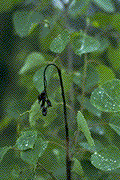Aspen and Poplar Leaf and Twig Blight
Venturia macularis (Fr.) E. Müller & Arx
(= Venturia tremulae Aderh.)
(anamorph = Pollaccia radiosa (Lib.) Bald & Cif.)
Venturia populina (Vuill.) Fabric.
(anamorph = Pollaccia elegans Servazzi)
Ascomycotina, Dothideales, Venturiaceae
Hosts: In B.C., Venturia macularis has been reported on aspen. Elsewhere in North America it has also been found on bigtooth aspen, white poplar, hybrid poplars, and eastern cottonwood. Throughout North America Venturia populina has been reported on balsam and lombardy poplar, cottonwood, and poplar hybrids.
Distribution: These fungi are widely distributed throughout the range of their hosts in B.C.
Identification: In the spring, young shoots and succulent terminal leaves wilt and turn black. Killed shoots droop, forming a characteristic shepherd's crook symptom (Figs. 61a, 61b, 61c). Lesions on shoots and leaves turn brownish black-olive green indicating the development of conidia. Perithecia with ascospores form on dead tissues in the fall and winter. Infections of V. macularis on aspen are primarily on terminal shoots on trees less than 3 m tall. Ventura populina infections occur on both terminal and lateral shoots throughout the crown of trees of all ages and sizes when environmental conditions favour infection (Fig. 61d).
Microscopic Characteristics: Venturia macularis: Ascomata immersed, globose to conical, erumpent, glabrous or setose, wall of brown polygonal cells, 80-140 µm diameter, setae 30-50 µm long, apical pore 25-50 µm wide. Asci oblong to saccate, bitunicate, 2-4-8-spored, 42-63 x 10-12 µm. Ascospores greenish-to-brown, elliptical to clavate, straight or inequilateral, 1-septate in the middle or below, slightly constricted, sometimes finely roughened, sometimes with a gelatinous coating, 8-14 x 4.5-6 µm. Acervuli irregular, olive-green. Conidiophores brown, nonseptate, 8-12 x 4-6 µm. Conidia brown, ellipsoid to cylindrical, straight or bent, 0-2 septate, 12-22 x 6-7 µm.
Venturia populina: similar to V. macularis but with larger ascospores (20-23 x 11-13 µm) and straight conidia (25-36 x 8-14 µm).
Damage: When moist weather conditions prevail during the growing season, V. macularis can kill most shoots in aspen stands regenerating by sprouting. Repeated infection results in stem deformity and growth reduction. These diseases are most severe in young stands, and have the greatest impact in intensively managed plantations.
References:
Dance, B. W. 1961. Leaf and shoot blight of poplars (section Tacamahaca) caused by Venturia populina (Vuill.) Fabric. Can. J. Bot. 39:875-890.
Figures
Click on any image to see the full size version.
Press "Back" on your browser to return to this screen.

Figure 61a: Necrotic shoots and leaves on aspen caused by Venturia macularis. Note characteristic "Shepherd's crook" symptoms.
Figure 61b: Necrotic shoots and leaves on aspen caused by Venturia macularis. Note characteristic "Shepherd's crook" symptoms.
Figure 61c: Necrotic shoots and leaves on aspen caused by Venturia macularis. Note characteristic "Shepherd's crook" symptoms.
Figure 61d: Defoliation caused by V. populina.